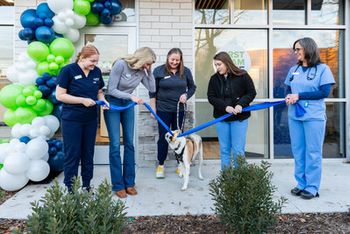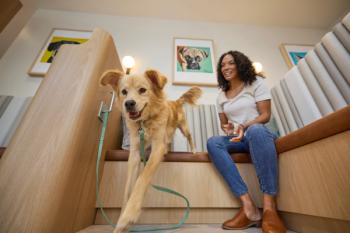
Modern facility, farmhouse charm
For 34 years, the doctors at Gunbarrel Veterinary Clinic in Boulder, Colo., cared for pets out of an old farmhouse. The building consisted of two exam rooms, a cramped treatment area, and a noisy kennel that shared a wall with an exam room.
FOR 34 YEARS, THE DOCTORS at Gunbarrel Veterinary Clinic in Boulder, Colo., cared for pets out of an old farmhouse. The building consisted of two exam rooms, a cramped treatment area, and a noisy kennel that shared a wall with an exam room.
When Dr. Louis Brad purchased the practice in 1992, the quarters weren't so tight; there were only three people on staff. But as Dr. Brad brought on associates, increased support staff, and grew the client base, the small farmhouse facility just couldn't cut it. "Before I knew it, there was no space to practice," he says. "And the noise grated on me every day."
The farmhouse sat on 5 acres of land, giving Dr. Brad the perfect location to build his new facility. His goals: cut down on noise and odor; make the practice efficient and easy to work in; and provide a homey, comfortable place that clients, staff members, and patients would enjoy. Dr. Brad thinks he's met these goals. And the judges of the 2005 Veterinary Economics Hospital Design Competition agreed, awarding Gunbarrel Veterinary Clinic a Merit Award.
Designing a dream
The experience of working in the old facility shaped Dr. Brad's goals for his new hospital. Noise and odor control topped the list, but he also wanted the practice to reflect his personality and style—warm and welcoming, like the old farmhouse he was practicing in. "While I wanted the practice to come into the next century, I didn't want the style to be cold or clinical," he says.
For much of the project, Dr. Brad took inspiration from those who've gone before him. "I poured over hundreds of floor plans and pictures of other people's facilities, visited other practices, and attended the Veterinary Economics Hospital Design Conference," he says. "An exhibitor at the conference recommended architect Kent Beierle, so I gave him a call."
Dr. Brad had talked with a few other architects, but the rapport just simply wasn't there. "I flew to Albuquerque to meet Kent. After a day-long meeting, I realized he was the right person for my project, and I signed a contract before I left!"
Dr. Brad already had plans scribbled out. Beierle filled in technical details and helped get the facility built. In the end, Dr. Brad says the final product isn't too far from his original plan.
Roadblocks and solutions
After toying with the idea of remodeling the old farmhouse, Dr. Brad quickly realized that building a brand-new facility on the same property would give him what he wanted. He assumed that because a veterinary practice already existed on this site, there'd be no problems building a new facility. However, Dr. Brad ran into issues with electricity and water service.
Reception: Distressed wood salvaged from a hay shed on site was incorporated into a finish surface for the curved reception desk and the timber soffit above the desk. A 4-foot-tall opening leads to a kids' play area with windows looking into the doggy daycare.
"We were told, at first, that we couldn't get electric service to the facility," he says. "Then they said it was possible, but that it would cost a great deal more than I'd expected." The water problem: A 1/2-inch water line ran into the old building. The new building needed a 1-and-1/2-inch water line, which the water company said could only be done by running pipe from a nearby subdivision. "The only problem with that solution was that it would have cost me an additional $80,000!" says Dr. Brad.
Make some changes early
Instead, he and his architect figured out a way to use the well already on the property, along with a series of cisterns that collect rainwater for use in watering the landscaping. "We avoided the big fee, and everything's working out nicely," Dr. Brad says.
Making the move
After all the design and construction challenges, it was finally moving day. "I may be blocking out the negatives, but I don't think the moving process was all that bad," says Dr. Brad. The team closed the practice at noon on a Friday; packed up everything, moved into the new facility, and began unpacking on Saturday; finished unpacking and cleaning up on Sunday; and opened for business as scheduled on Monday morning.
Hospital design
It helped that the hospital team was able to stock much of the new facility ahead of time. "The new, larger facility required many more supplies than the farmhouse," he says. "So we were able to move those items in early. And all of our staff members and some of their family members pitched in, which made the move quick and more fun."
In the end, Dr. Brad got the warm, homey practice he set out to build. And the additional space and better materials allowed him to control noise and odor. "I never hear the dogs barking," he says. The extra space also allowed for better organization, room to move, and a more comfortable working environment.
"That's pretty much all I wanted," he says. "I had no idea what I was getting into when starting this. I thought, 'We'll just do this little project.' And that little project took on a life of its own. I never thought it would be as big of a project as it was; the building went way beyond what I thought I'd do and what I thought I'd spend. But I'm glad I did it. And no, I wouldn't do it again!"
The biggest surprise Dr. Brad faced was the emotional rollercoaster that accompanied this undertaking. "I experienced my highest highs and my lowest lows during this project—sometimes on the same day," he says. "One day while meeting with the bank, I was told my proposal had been accepted. I was on Cloud 9. Then, I got back to work and found that a new septic system was needed and that the state required a study on water usage. This study could take up to two years. Within 15 minutes of my lunch meeting, I was crushed."
Fortunately, Dr. Brad was able to prove that there was no need for the two-year study, resolving the problem. But he says no one ever warned him about the emotional fluctuations that come with the building process—something he believes every practitioner needs to know before getting started on any large project.
Happily, Dr. Brad's ride had a smooth finish: In the first year alone, practice growth jumped 27 percent, compared to a previous average of 12 percent. And clients love the new facility, he says.
"Not a day goes by that someone doesn't comment on how much they like the new practice. I haven't heard any negative comments. And I love the place!"
Sarah A. Moser is a freelance writer and editor in Olathe, Kan. Please send questions or comments to
Newsletter
From exam room tips to practice management insights, get trusted veterinary news delivered straight to your inbox—subscribe to dvm360.




